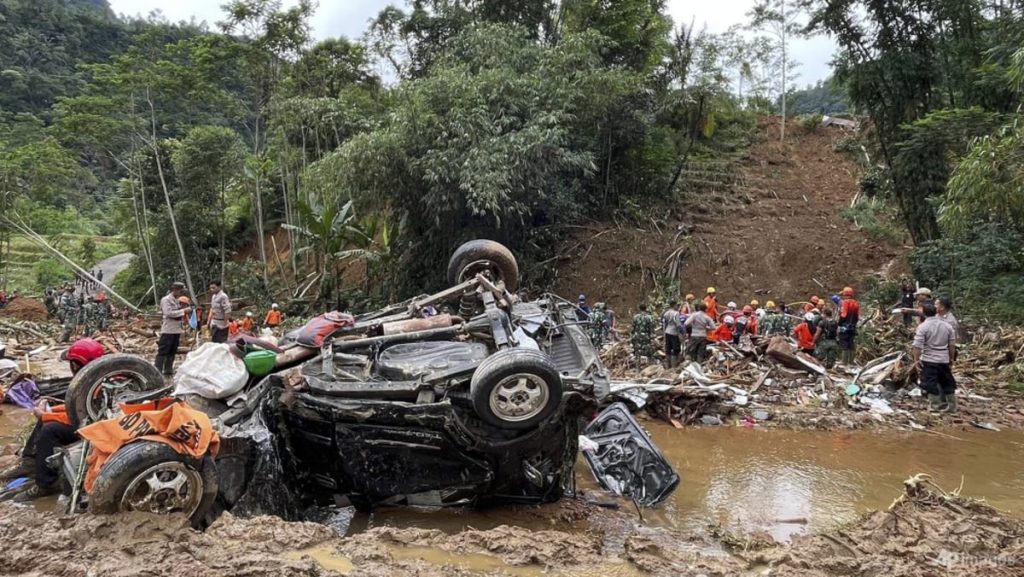The devastating landslide that struck Kasimpar village in Indonesia underscores the nation’s vulnerability to natural disasters, particularly during the rainy season. Heavy equipment has been deployed to the village to sift through the wreckage and debris, focusing primarily on two locations: the residence of a local official and a nearby cafe. Both structures are believed to have collapsed under the force of the landslide, burying those who sought refuge within. Rescuers are also searching the adjacent river, acknowledging the possibility that victims may have been swept away by the strong currents generated by the landslide. The confirmed death toll stands at 13, with the potential for this number to rise as search and rescue operations continue. This tragedy highlights the precarious balance between human settlements and the powerful forces of nature, especially in regions prone to extreme weather events.
Indonesia’s geographical characteristics and tropical climate make it particularly susceptible to landslides, especially during the monsoon season, which typically spans from November to April. The archipelago nation experiences heavy rainfall during this period, saturating the soil and increasing the risk of slope instability. Deforestation, often driven by agricultural expansion and logging activities, further exacerbates this vulnerability by removing the natural vegetation that helps bind the soil and prevent erosion. The combination of heavy rainfall and denuded slopes creates a perfect storm for landslides, often with catastrophic consequences for communities situated in mountainous or hilly terrain. While landslides are most common during the rainy season, recent years have witnessed an increase in weather-related disasters occurring outside of this traditional timeframe, possibly indicating a shift in weather patterns influenced by climate change.
The impact of climate change is becoming increasingly evident in Indonesia, manifesting in more intense storms, heavier rainfall, and increased frequency of flash floods. Warmer temperatures lead to greater evaporation, resulting in more moisture in the atmosphere and subsequently, heavier downpours. These intensified rainfall patterns overwhelm drainage systems and contribute to flash floods, which can carry large volumes of debris and sediment, further amplifying the destructive power of landslides. The increased frequency and intensity of these extreme weather events pose a significant challenge to disaster preparedness and mitigation efforts, necessitating a comprehensive approach that incorporates both short-term emergency response and long-term strategies for climate adaptation and resilience.
The recent landslide in Kasimpar village is not an isolated incident; it forms part of a concerning trend of weather-related disasters impacting Indonesia. In May 2024, another tragedy unfolded in West Sumatra, where heavy rains triggered flash floods that claimed the lives of at least 67 people. In this instance, the floods carried a deadly mixture of volcanic ash, sand, and pebbles from the eruption of Mount Marapi, inundating residential areas and causing widespread devastation. This event highlights the compounding effect of multiple natural hazards, where volcanic activity coupled with extreme rainfall can create particularly hazardous conditions. The convergence of these factors underscores the need for integrated disaster risk management strategies that address the interconnectedness of various natural threats.
The recurrence of such disasters underscores the urgent need for a multi-pronged approach to disaster risk reduction in Indonesia. This includes strengthening early warning systems, implementing sustainable land management practices, and investing in infrastructure that can withstand extreme weather events. Effective early warning systems can provide crucial time for communities to evacuate and minimize casualties. Sustainable land management practices, such as reforestation and terracing, can help stabilize slopes and reduce the risk of landslides. Investing in resilient infrastructure, including flood defenses and reinforced buildings, can mitigate the impact of floods and landslides on communities.
Furthermore, addressing the root causes of climate change is paramount. Reducing greenhouse gas emissions through a transition to renewable energy sources and promoting sustainable development are essential steps in mitigating the long-term risks associated with climate change. International collaboration and support are crucial in assisting Indonesia in implementing these measures and building its capacity to cope with the increasing challenges posed by a changing climate. The frequency and severity of these disasters serve as a stark reminder of the interconnectedness of human societies and the natural environment and the urgent need for collective action to mitigate the risks and build a more resilient future.

